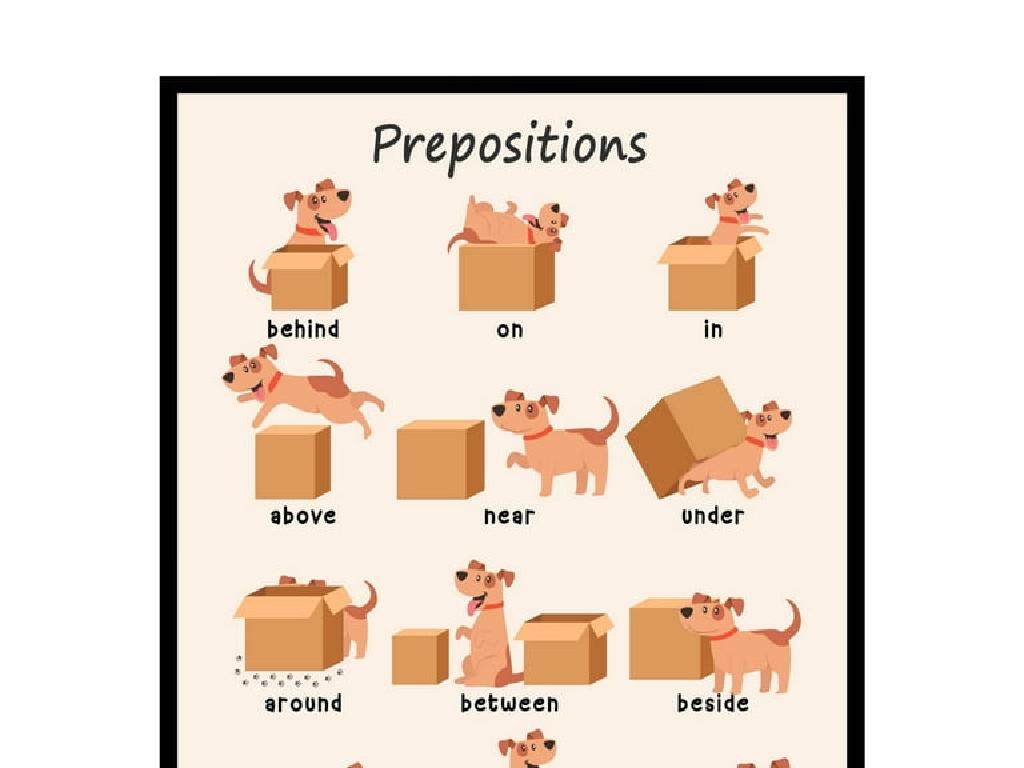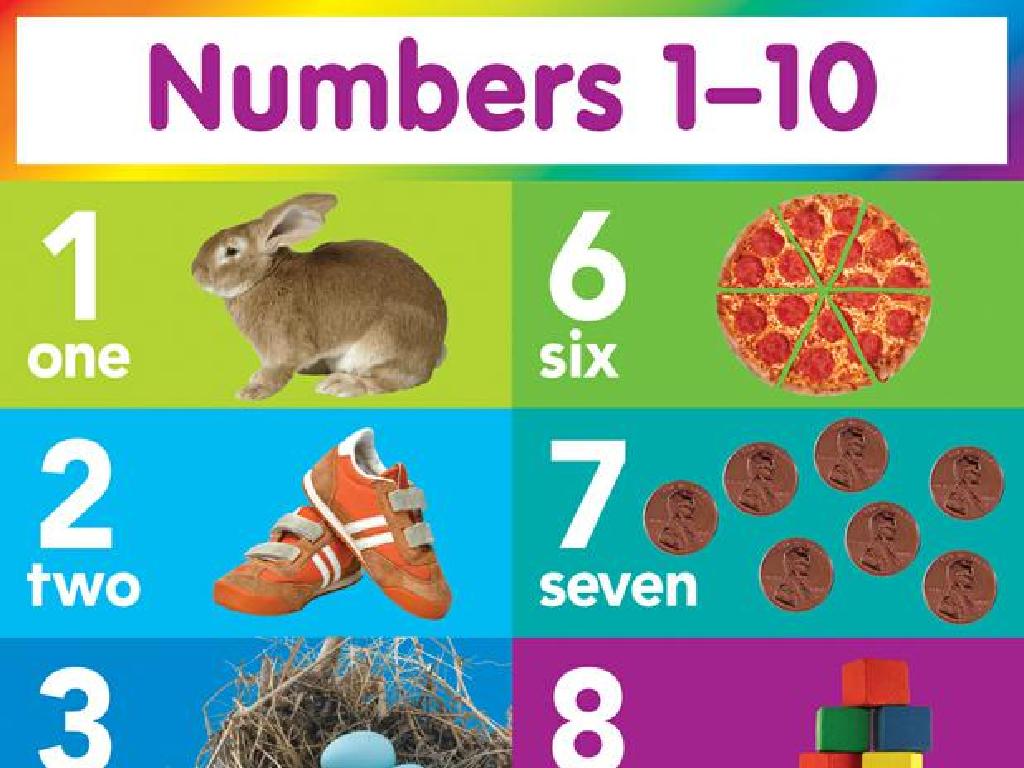Complete The Poem With A Word That Rhymes
Subject: Language arts
Grade: Second grade
Topic: Rhyming
Please LOG IN to download the presentation. Access is available to registered users only.
View More Content
Welcome to Rhyming Words!
– Learn about rhyming words
– Rhymes sound the same at the end
– Like ‘cat’ and ‘hat’ have similar ending sounds
– Rhyming makes poetry fun
– Rhymes add rhythm to poems and songs
– Create your own rhymes
– Use rhymes to make a short poem or song
|
This slide introduces second graders to the concept of rhyming words, an essential part of poetry and songwriting. Emphasize that rhyming words have the same ending sounds, which makes them sound pleasant together. Explain that rhyming can make poetry and songs more enjoyable and memorable. Encourage the students to listen for rhymes in their favorite songs or poems. As an activity, ask the students to think of words that rhyme with their own names or common objects in the classroom. This will prepare them for creating their own simple rhymes and understanding the pattern in poems and songs.
What is a Rhyme?
– Rhymes have the same ending sound
– Example: ‘cat’ and ‘hat’
– Words that sound similar at the end, like ‘cat’ and ‘hat’
– Rhyming words end with ‘at’
– Both words share the ‘at’ sound, making them rhyme
– Can you find rhyming words?
– Try to think of words that sound like ‘cat’ and ‘hat’
|
This slide introduces the concept of rhyming to second-grade students. Start by explaining that rhymes are words that sound the same at the end. Use simple, familiar words as examples, such as ‘cat’ and ‘hat’, to illustrate this point. Encourage the students to actively participate by thinking of other words that rhyme with ‘cat’ and ‘hat’. This will help them understand the concept of rhyming and how it is used in poems and songs. Make sure to praise their efforts and provide guidance if they struggle to come up with rhyming words. This activity will set the foundation for further lessons on rhyming and poetry.
Finding Rhymes in Poems
– Poems create rhythm with rhymes
– Read a poem together in class
– We’ll read aloud and discover the rhymes
– Listen carefully for rhyming words
– Words that sound the same at the end
– Raise your hand when you hear rhymes
|
This slide is designed to introduce second graders to the concept of rhyming within poems. Start by explaining that poems often have a beat or rhythm, much like music, and rhyming words help create this. Read a selected poem aloud to the class, emphasizing the rhyming words. Encourage active listening and participation by asking students to raise their hands when they recognize words that rhyme. This interactive approach helps students develop phonemic awareness and enjoy the musical quality of poetry. After the reading, discuss the rhyming words they identified and possibly explore why the poet may have chosen those particular words to rhyme.
Let’s Practice Rhyming!
– We’ll play a fun rhyming game
– I say a word, you find a rhyme
– If I say ‘cat’, you might say ‘hat’
– Rhymes have matching ending sounds
– It’s not about the start, but how it ends!
– Let’s see how many rhymes we find!
|
This slide introduces a classroom activity focused on rhyming words, which is a key skill in phonological awareness for second graders. Start the activity by explaining that rhyming words have the same ending sounds, like ‘cat’ and ‘hat’. Demonstrate with a few examples, then let the students take turns. Encourage them to listen carefully to the word you say and think of a word that ends with the same sound. If a student is stuck, give them hints or choices to help them find a rhyming word. Make sure to celebrate all attempts at rhyming to build confidence. This activity can be done in a group or one-on-one. It’s a great way to reinforce listening skills and phonemic awareness.
Creating Our Own Rhymes
– It’s your turn to rhyme
– Choose a word to start
– Pick any word you like
– Write down rhyming words
– How many rhymes can you find?
– Share with the class
– Tell us your rhymes!
|
This slide is designed to engage students in a creative activity where they practice rhyming, an essential skill in reading and poetry. Encourage students to think of a word they are familiar with and then brainstorm as many rhyming words as possible. Provide examples if needed, such as ‘cat’ ‘bat’, ‘hat’, ‘rat’, ‘mat’. After they have created their list, ask them to share with the class to foster a collaborative learning environment. This activity will help them recognize patterns in word endings and enhance their phonological awareness. For the teacher: be prepared with a list of words suitable for second graders in case some students struggle to find a starting word. Also, have a rhyming dictionary or list ready to help students who may have difficulty finding rhymes.
Rhyme Time: Complete the Poem
– Poem with missing words
– Fill blanks with rhyming words
– Find words that sound the same at the end
– Example to do together
– We’ll do the first one as a class activity
– Practice rhyming skills
– Helps with reading and creativity
|
This slide introduces a class activity focused on rhyming. Present a poem with missing words to the students and ask them to fill in the blanks with words that rhyme with the given text. Start with a group example to demonstrate the concept. This exercise will help students understand rhyming patterns, enhance their phonemic awareness, and encourage creative thinking. As they engage with the poem, they’ll also improve their vocabulary and reading skills. For the teacher: prepare a list of rhyming words that fit the poem in case students need assistance and be ready to guide them through the process.
Class Activity: Rhyme Time
– We’re writing a class poem together
– Each student adds one rhyming line
– Think of words that sound like the last word used
– Your line should rhyme with the one before
– If the last word was ‘cat’, your word could be ‘hat’
– Let’s make our class poem shine!
|
This activity is designed to engage students in understanding and applying rhyming patterns. Start by explaining what a rhyme is and give examples. Then, begin the poem with an opening line and ask a student to add a line that rhymes with it. Continue this process, going around the room, allowing each student to contribute. Encourage creativity and assist students who may struggle to find a rhyming word. Have a list of rhyming words ready to prompt or guide students if they get stuck. The goal is to create a collaborative poem where each line rhymes with the previous, fostering a fun and educational experience in rhyming and poetry.
Review and Share: Rhyming Recap
– Review today’s rhyming words
– Share your class poem rhymes
– Each student shares the rhyme they added
– Celebrate our rhyme learning
– Encourage rhyming practice at home
– Try to make up rhymes with family
|
This slide is meant to conclude the lesson on rhyming. Start by revisiting the rhyming words that were discussed during the lesson. Then, have each student share the rhyming word they contributed to the class poem, fostering a sense of accomplishment. Praise the students for their efforts in learning about rhymes. Encourage them to continue practicing by finding rhyming words at home, perhaps by reading poems with family members or creating their own simple rhymes. This activity reinforces their understanding of rhyming words and helps build their confidence in creating rhymes independently.
Homework Challenge: Rhyme Time Poem
– Take home your rhyming worksheet
– Fill in the blanks with rhymes
– Find words that sound the same at the end
– Complete the poem creatively
– Use your imagination for fun rhymes
– Share your poem in class tomorrow
|
This homework challenge is designed to help students practice their rhyming skills, which is an essential part of phonemic awareness in language arts. The worksheet will have a poem with missing words, and students must use their knowledge of rhymes to fill in the blanks. Encourage creativity and remind them that rhyming words have the same ending sounds. In the next class, create a supportive environment where each student can proudly share their completed poem. This activity will not only reinforce their understanding of rhymes but also boost their confidence in writing and speaking.






